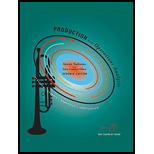
Concept explainers
a)
Interpretation: utilization of employees.
Concept introduction: The M/M/1 queue assumes poisonarrivals, exponential service times, and a single server serving customers in a FCFS fashion. Poisson arrivals are a reasonably good assumption for unscheduled systems. Further if there is a mix of many different types of jobs the exponential distribution can be realistic for service times. Otherwise it tends to be too variable of a distribution.
b)
interpretation: the average time an email spends waiting before an employee starts working on it.
concept introduction:The M/M/1 queue assumes poison arrivals, exponential service times, and a single server serving customers in a FCFS fashion. Poisson arrivals are a reasonably good assumption for unscheduled systems. Further if there is a mix of many different types of jobs the exponential distribution can be realistic for service times. Otherwise it tends to be too variable of a distribution.
c)
Interpretation:average number of emails in the system waiting to be worked on.
Concept introduction: The M/M/1 queue assumes poison arrivals, exponential service times, and a single server serving customers in a FCFS fashion. Poisson arrivals are a reasonably good assumption for unscheduled systems. Further if there is a mix of many different types of jobs the exponential distribution can be realistic for service times. Otherwise it tends to be too variable of a distribution.
D)
Interpretation:options available to decrease customers waiting.
Concept introduction:The M/M/1 queue assumes poison arrivals, exponential service times, and a single server serving customers in a FCFS fashion. Poisson arrivals are a reasonably good assumption for unscheduled systems. Further if there is a mix of many different types of jobs the exponential distribution can be realistic for service times. Otherwise it tends to be too variable of a distribution.
Want to see the full answer?
Check out a sample textbook solution
Chapter 7 Solutions
Production and Operations Analysis, Seventh Edition
- Repair calls are handled by one repairman at a photocopy shop. Repair time, including travel time, is exponentially distributed, with a mean of 2.5 hours per call. Requests for copier repairs come in at a mean rate of 2.1 per eight-hour day (assume Poisson). a. Determine the average number of customers awaiting repairs. (Round your answer to 2 decimal places.) Number of customers b. Determine system utilization. (Round your answer to the nearest whole percent. Omit the "%" sign in your response.) System utilization % c. Determine the amount of time during an eight-hour day that the repairman is not out on a call. (Use your rounded answer from Part b. Round your answer to 2 decimal places.) Amount of time hours d. Determine the probability of two or more customers in the system. (Do not round intermediate calculations. Round your answer to…arrow_forwardPlease do not give solution in image format thanku Dan himself came to your store and wanted to know how long customers were waiting in line (this is very important to Dan!). Report the time customers wait in your queue if you have 2 cashiers open, 55 customers come into the store per hour and your cashiers take 1.9 minutes per customer to ring them up.arrow_forwardConsider a bank branch that has three distinct customer arrival patterns throughout the day, as measured by average arrival rates (below). Morning (8:30 - 11:30): arrival 1 = 47 per hour. %3D Lunch (11:30 - 1:30): arrival 2 = 70 per hour. Afternoon (1:30 - 4:00): arrival 3 = 30 per hour. Regardless of the time of day, the average time it takes for a teller to serve customers is 3.17 minutes. Because of competition with other banks in the area, management has developed an internal goal to keep the average customer wait before service to be less than 4 minutes. With that in mind, answer the following: a. During the morning period, what is the minimum number of tellers that the bank needs to hire to achieve the 4-minute service goal mentioned above? [ Select] b. During lunch, what is the minimum number of tellers that the bank needs to hire to achieve the 4 minute service goal mentioned above? [ Select ] c. In the afternoon, what is the minimum number of tellers that the bankarrow_forward
- Experience the Tour de France (ETF) is a specialty travel agent. It arranges vacations for amateur cyclists who want to experience the Tour de France by riding through one or more stages in the race. It has five people who take calls from clients. Each call lasts on average 25 minutes, with a standard deviation of 50 minutes. A call arrives on average every 20 minutes with a standard deviation of 20 minutes. (Do not round intermediate calculations. Round your answer to two decimal places.) On average, how many minutes does a caller wait before talking to an agent? minutesarrow_forwardIn an M/MA queueing system, the arrival rate is 3 customers per hour and the service rate is 5 customers per hour. If the service process is automated (resulting in no variation in service times but the same service rate), what will be the resulting performance measurements? (Round your answers to 3 decimal places.) a. What is the utilization? Utilization b. What is the expected number of customers in the system (L)? Number of customers c. What is the expected waiting time (in hours) for the system (W)? Waiting time(in hours)arrow_forwardIn waiting line management, system performance measures include which of the following: I. an arriving customer will have to wait. II. The average number of customers waiting. III. The average time customers spend in the system. IV The probability that the server is busy. Select one: a. II, III & IV b. I, II & III c. I, II & IV d. I, III & IV convert inputs into outputs; they are at the core of operations management. Select one: a. processes b. decisions C. resources d. products ооооarrow_forward
 Practical Management ScienceOperations ManagementISBN:9781337406659Author:WINSTON, Wayne L.Publisher:Cengage,
Practical Management ScienceOperations ManagementISBN:9781337406659Author:WINSTON, Wayne L.Publisher:Cengage,
